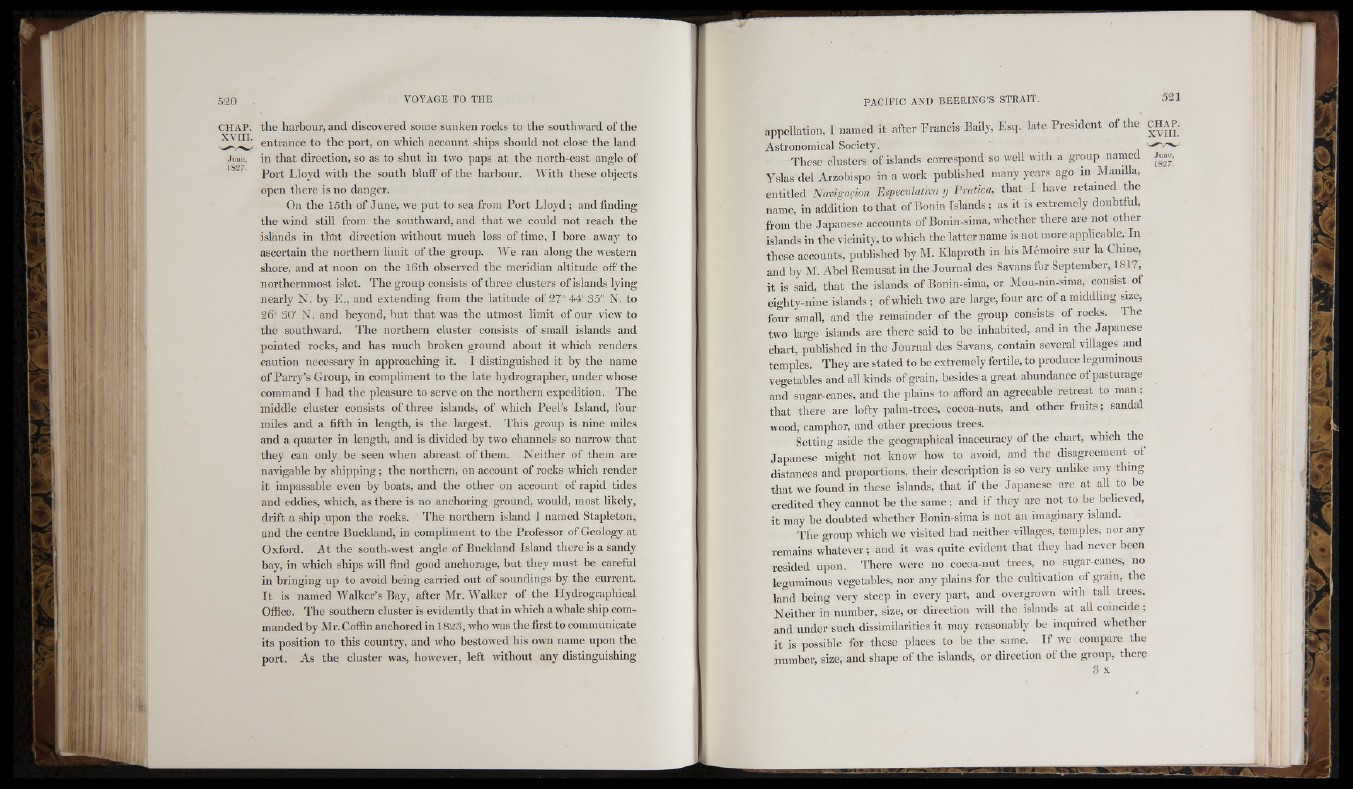
toil:
the harbour, and discovered some sunken rocks to the southward of the
entrance to the port, on which account ships should not close the land
in that direction, so as to shut in two paps at the north-east angle of
Port Lloyd wdtli the south bluff of the harbour. With these objects
open there is no danger.
On the 15th of June, we put to sea from Port Lloyd ; and finding
the wind still from the southward, and that we could not reach the
islands in that direction without much loss of time, 1 bore away to
ascertain the northern limit of the group. AVe ran along the western
shore, and at noon on the 16th observed the meridian altitude offthe
northernmost islet. The group consists of three clusters of islands lying
nearly N . by E., and extending from the latitude of 27° 44' 35" N. to
26“ .30' N. and beyond, but that was the utmost limit of our view to
the southward. The northern cluster consists of small islands and
pointed rocks, and has much broken ground about it which renders
caution necessary in approaching it. 1 distinguished it by the name
of Parry’s Group, in compliment to the late hydrographer, under whose
command I had the pleasure to serve on the northern expedition. 'I'he
middle cluster consists of three islands, of which Peel’s Island, four
miles and a fifth in length, is the largest. 'Phis group is nine miles
and a quarter in length, and is divided by two channels so narrow that
they can only be seen when abreast of them. Neither of them are
navigable by shipping; the northern, on account of rocks which render
it impassable even by boats, and the other on account of rapid tides
and eddies, which, as there is no anchoring ground, would, most likely,
drift a ship upon the rocks. The northern island J named Stapleton,
and the centre Buckland, in compliment to the Professor of Geology at
Oxford. At the south-west angle of Buckland Island there is a sandy
bay, in which ships will find good anchorage, but they must be careful
in bringing up to avoid being carried out of soundings by the current.
It is named AValker’s Bay, after Mr. AA"alker of the Hydrographical
Office. The southern cluster is evidently that in which a whale ship commanded
by Mr. Coffin anchored in 1823, wlio was the first to communicate
its position to this country, and who bestowed his own name upon the
port. As the cluster was, however, left without any distinguishing
appellation, I named it after Francis Baily, Esq. late President o fth e CHAP.
Astronomical Society.
June,
1827.
These clusters of islands correspond so well with a group named
Yslas del Arzobispo in a work published many years ago in Manilla,
entitled Nadgacion Especvlatka y Pratica, that I have retained the
name, in addition to that of Bonin Islands; as it is extremely doubtful,
from the Japanese accounts of Bonin-sima, whether there are not other
islands in the vicinity, to which the latter name is not more applicable. In
these accounts, published by M. Klaproth in his Mémoire sur la Chine,
and by M. Abel Eemusat in the Journal des Savans for September, 1817,
it is said, that the islands of Bonin-sima, or Mou-nin-sima, consist of
eighty-nine islands ; of which two are large, four are of a middling size,
four small, and the remainder of the group consists of rocks. The
two large islands are there said to be inhabited, and in the Japanese
chart, published in the Journal des Savans, contain several villages and
temples. They are stated to be extremely fertile, to produce leguminous
vegetables and all kinds of grain, besides a great abundance of pasturage
and sugar-canes, and the plains to afford an agreeable retreat to man ;
that there are lofty palm-trees, cocoa-nuts, and other fruits ; sandal
wood, camphor, and other precious trees.
Setting aside the geographical inaccuracy of the chart, which the
Japanese might not know how to avoid, and the disagreement of
distances and proportions, their description is so very unlike any thing
that we found in these islands, that if the Japanese are at all to be
credited they cannot be the same ; and if they are not to be believed,
it may be doubted whether Bonin-sima is not an imaginary island.
The group which we visited had neither villages, temples, nor any
remains wliatever ; and it was quite evident that they had never been
resided upon. There were no cocoa-nut trees, no sugar-canes, no
leguminous vegetables, nor any plains for the cultivation of gram, the
land being very steep in every part, and overgrown with tall trees.
Neither in number, size, or direction will the islands at all coincide ;
and under such dissimilarities it may reasonably be inquired whether
it is possible for these places to be the same. If we compare the
number size, and shape of the islands, or direction of the group, there
3 X